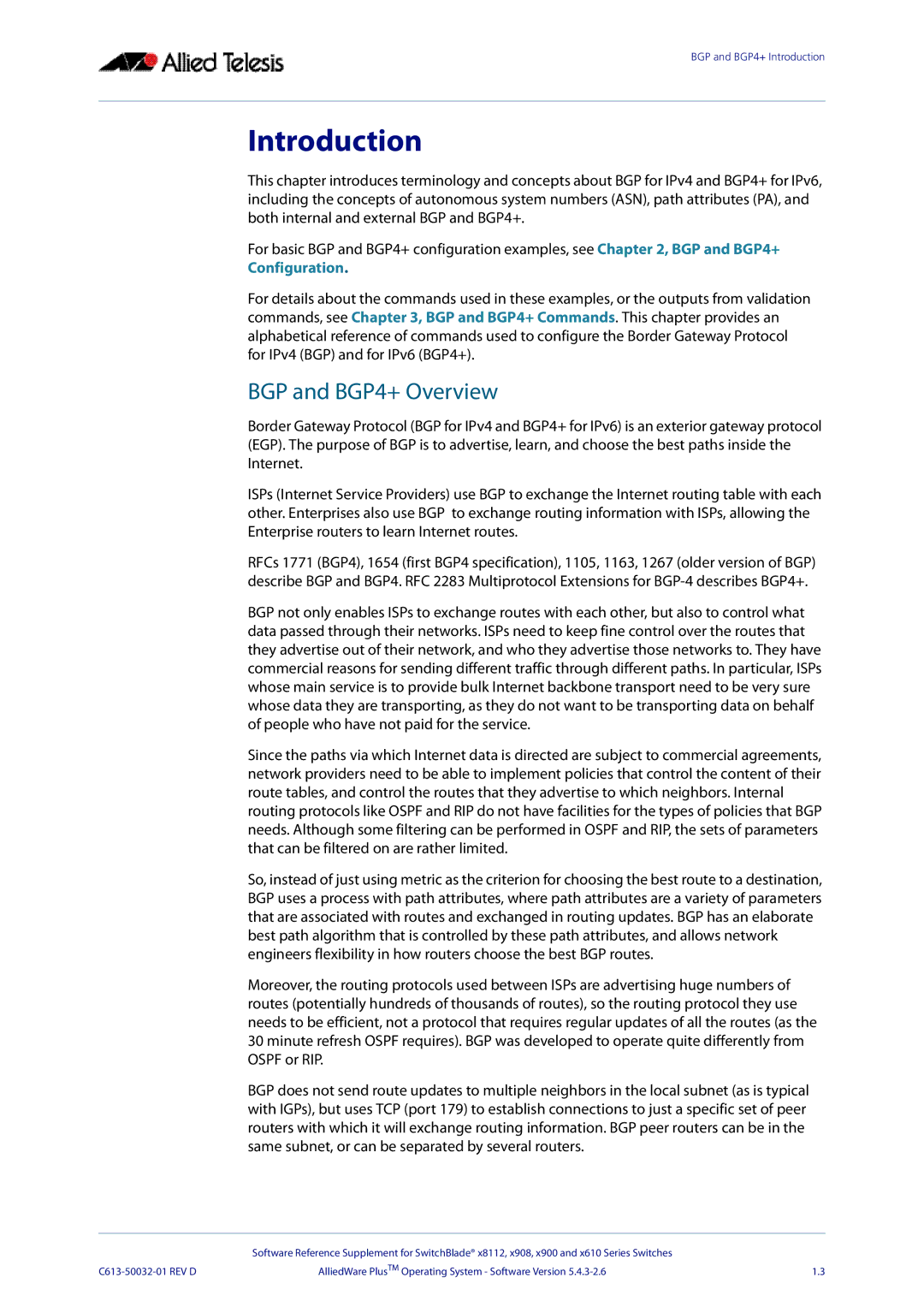
BGP and BGP4+ Introduction
Introduction
This chapter introduces terminology and concepts about BGP for IPv4 and BGP4+ for IPv6, including the concepts of autonomous system numbers (ASN), path attributes (PA), and both internal and external BGP and BGP4+.
For basic BGP and BGP4+ configuration examples, see Chapter 2, BGP and BGP4+
Configuration.
For details about the commands used in these examples, or the outputs from validation commands, see Chapter 3, BGP and BGP4+ Commands. This chapter provides an alphabetical reference of commands used to configure the Border Gateway Protocol for IPv4 (BGP) and for IPv6 (BGP4+).
BGP and BGP4+ Overview
Border Gateway Protocol (BGP for IPv4 and BGP4+ for IPv6) is an exterior gateway protocol (EGP). The purpose of BGP is to advertise, learn, and choose the best paths inside the Internet.
ISPs (Internet Service Providers) use BGP to exchange the Internet routing table with each other. Enterprises also use BGP to exchange routing information with ISPs, allowing the Enterprise routers to learn Internet routes.
RFCs 1771 (BGP4), 1654 (first BGP4 specification), 1105, 1163, 1267 (older version of BGP) describe BGP and BGP4. RFC 2283 Multiprotocol Extensions for
BGP not only enables ISPs to exchange routes with each other, but also to control what data passed through their networks. ISPs need to keep fine control over the routes that they advertise out of their network, and who they advertise those networks to. They have commercial reasons for sending different traffic through different paths. In particular, ISPs whose main service is to provide bulk Internet backbone transport need to be very sure whose data they are transporting, as they do not want to be transporting data on behalf of people who have not paid for the service.
Since the paths via which Internet data is directed are subject to commercial agreements, network providers need to be able to implement policies that control the content of their route tables, and control the routes that they advertise to which neighbors. Internal routing protocols like OSPF and RIP do not have facilities for the types of policies that BGP needs. Although some filtering can be performed in OSPF and RIP, the sets of parameters that can be filtered on are rather limited.
So, instead of just using metric as the criterion for choosing the best route to a destination, BGP uses a process with path attributes, where path attributes are a variety of parameters that are associated with routes and exchanged in routing updates. BGP has an elaborate best path algorithm that is controlled by these path attributes, and allows network engineers flexibility in how routers choose the best BGP routes.
Moreover, the routing protocols used between ISPs are advertising huge numbers of routes (potentially hundreds of thousands of routes), so the routing protocol they use needs to be efficient, not a protocol that requires regular updates of all the routes (as the 30 minute refresh OSPF requires). BGP was developed to operate quite differently from OSPF or RIP.
BGP does not send route updates to multiple neighbors in the local subnet (as is typical with IGPs), but uses TCP (port 179) to establish connections to just a specific set of peer routers with which it will exchange routing information. BGP peer routers can be in the same subnet, or can be separated by several routers.
| Software Reference Supplement for SwitchBlade® x8112, x908, x900 and x610 Series Switches |
|
AlliedWare PlusTM Operating System - Software Version | 1.3 |
